
Trying to minimise merch can be a challenge.
What’s known in the industry as Solar Christmas is over for another year. At each of these events we seem to have an underlying theme. It was batteries last year, and nondescript white 5kW boxes the year before.
So what was big this year? Stackable all-in-one solutions.
Hosted at the Melbourne Convention and Exhibition Centre, otherwise known as Jeff’s Shed, All Energy keeps getting bigger, which means I spent the whole first day stalking the aisles. Unlike events prior, the entire main hall was fillled with energy, so we didn’t have to share the space with the Waste Expo, the rubbish trucks were in another hall altogether.
Best quote of the day: “If they really want to encourage Australian Made, they could start with lowering the price of display space here. In square metre terms I can buy and own factory real estate for less than we pay to hire space here for two days,” – Rod Scott, CEO Selectronic.
Considering the eye-watering expense, you’d think the organisers would have a slick, mobile friendly app to help you navigate the place, but you’d be wrong. They print books and the online version is just the 380 page, advert filled proof, sent to the printers. Fine if you’re carrying a desktop display & mouse.
The punters don’t want to carry books, they literally take photos of the wall chart with their mobile.

Compare the screenshot of the utterly useless online map, when even the 2.4 metre high wall chart needs decent sized numbers.
What I Found Interesting
There was an entire section dedicated to electric mobility and EV charging, this took up even more floor space than previously occupied by the waste expo.
There were all manner of products from electrical infrastructure, payment organisers, DC chargers, AC chargers, bi-directional chargers and more.
Tap ‘n Go
Finally someone has developed tap & go payment for EV charging and demonstrated it worked. Not tied to any particular hardware, Nayax showed the process of plugging in, tapping the card and counting three, two, one… click! All they’ll have to do is educate the end user to tap their card a second time to stop charging.
Canyon Cable Management
I might write a whole article on the 4 different solar carports, but the clear winner was a local solution for EV charging leads. Using an inclined rail and linear bearing, Canyon are keeping the cables off the ground.
To be frank I think the biggest problem they’ll have is dissuading the drunks from thinking it’s a fun park ride.

This looked really well thought out
BiDi Is The Next Big Thing
With what I’ll call interesting brand marketing, UUgreenpower had some bi-directional car chargers on the wall with AS4777 approved stickers on them. It’ll be interesting to see how they go with network approvals and how many years the CEC will take to list them.

Lighting on these tradeshow stands makes getting a decent photograph impossible
Speaking of interesting branding, the people at eCactus have worked out they’re the butt of a few jokes in the Australian vernacular, so they have a new brand name. The external appearance is still that of pretty cheap gear.
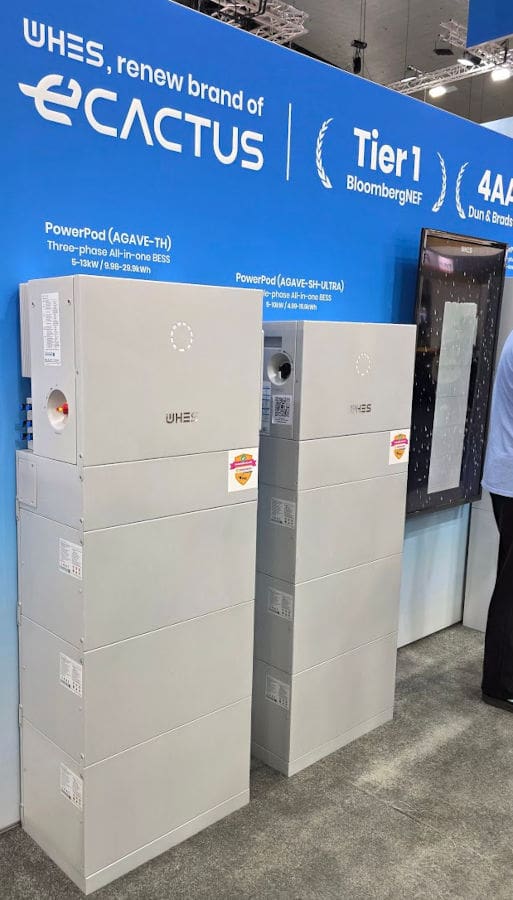
Mate; that branding you’ve got is cactus.
Delta Are Tapping Out
The rep I spoke to said Delta are sadly no longer offering solar inverters, though they still honour the warranties on units returned to them.
They are focussing more on EV charging now with the likes of a 50kW DC fast charger in a pole mount configuration. Plus they have their 5th generation of domestic 7/22kW EVSE which is apparently “bi-directional ready” like many others are also claiming.
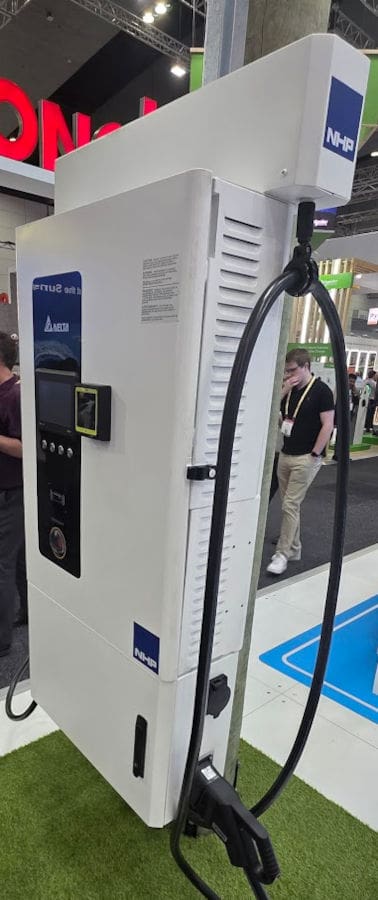
50kW DC car charger. Cable management here relies on a spring loaded retractor, much like some petrol stations
We may need to start a public awareness campaign on this terminology, because something that’s dealing with AC as bi-directional is relying on the inverter/charger in the car to do the work. An EVSE on the wall is little more than a glorified extension cord so promising bi-directional is akin to having a “battery ready” solar inverter. ie any inverter is battery ready if you have an AC coupled battery.
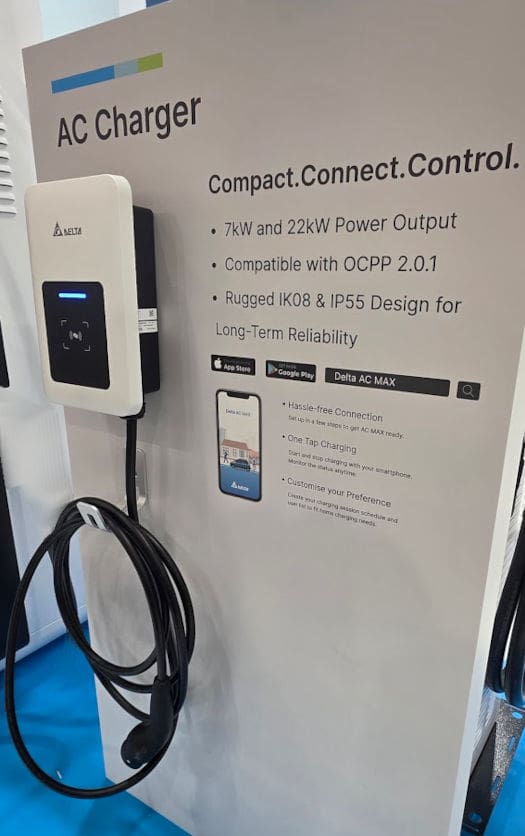
There’s an RFID function on this unit so you can tap it with a card or maybe a phone to activate it.
Mitsubishi Fuso eCanter Appeared
Without a word of explanation there was a nice new delivery truck cab-chassis sitting on the floor. How these aren’t already a thing is beyond me.
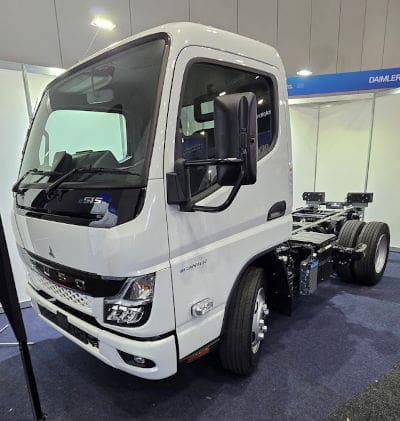
Nothing new to see here because it’s just a simple little truck.
Diesel is a huge percentage of delivery costs and converting a truck chassis to electric doesn’t involve designing a new vehicle at all. If fact this system looks like it would be ideal for repowering old trucks. With standardised chassis rail spacing, the important parts of this EV will just bolt across.
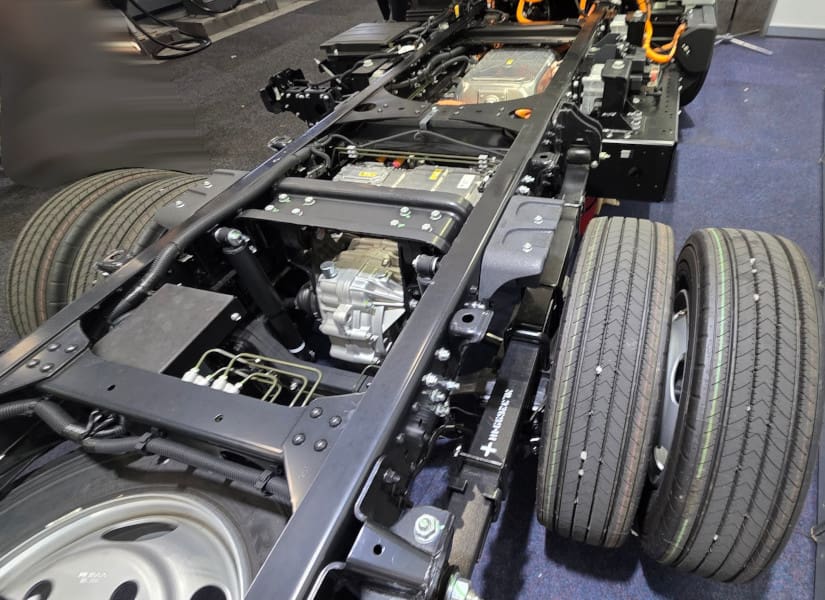
Using the same leaf spring chassis, this truck has a DeDion axle and drive shafts from a central transaxle motor unit.
A Tonne Of Hot Water
More than a few heat pumps showed up but this 1000 litre monster from Reclaim was impressive, showing that heat pumps are mature enough to take on the commercial market for large scale hot water systems with ring mains.

The scale of this thing was impressive.
We were also seeing more manufacturers taking a holistic home energy management system view. Personally I don’t think you could pay me to use Midea, but it’s good know they’re saving energy and getting on with making things simple for the end user with any luck.

Heat pump hot water, air conditioner, solar, battery, inverter & EVSE all in one ecosystem.
Other notable product launches included GoodeWe’s new ESA all-in-one home battery systems, Aiko’s claim of a world-first 500 W panel under 2m², and TrinaSolar’s new generation of Vertex S+ high-power solar panels.
There was also plenty on the agenda with presentations and seminars, as over 500 speakers tackled a range of issues, including the fallout from the battery rebate boom.
Sign up for our free weekly newsletter to get emailed a full rundown of our coverage of All Energy Australia delivered next Tuesday.

 RSS - Posts
RSS - Posts



Great to see investment and new ideas coming together.
On the Electric truck. They have been in Australia for several years. Issues are massive increase to Tare weight. The NHVR are looking into increasing axle weights for heavy vehicles to accommodate this.
The other issue is these trucks are limited to city driving as they can’t go far before needing charging again.
Although there is one company Janus on the Central Coast of NSW. That is putting electric motors in older trucks. Some of these trucks are going from Sydney to Melbourne and they stop at Albury where a forklift removes the battery and puts in a charged one so the truck can continue.
I think that city and suburban environments would be the best place to start with electric trucks, particularly ones of this size:
– always within 50-100km of base
– always close to recharging depots in an emergency
– diesel is least efficient and most polluting when accelerating and decelerating (in comparison to the same engine running at a reasonably constant speed on the highway.)
– much less noise
I think getting this type of ICE vehicle out of city and suburbans would offer the most bang for your tax dollars in terms of environmental benefits. (Sorry, only a feeling, I haven’t seen and haven’t calculated any numbers.)
I agree with your sentiment in my post. These trucks are currently limited to large cities doing deliveries. The issue with this is deliveries are done in the day. Do the trucks are charged at night when renewables are not available.
Hi Warren,
We should point out the wind does blow at night.
You can watch it here.
https://explore.openelectricity.org.au/energy/nem/?range=3d&interval=30m&view=discrete-time&group=Detailed
See
https://www.pv-magazine-australia.com/2025/10/31/electric-truck-achieves-480-kilometre-delivery-on-single-charge/
“The other issue is these trucks are limited to city driving as they can’t go far before needing charging again.”
GJ – That is another myth re EVs including now trucks. In the US and Europe etrucks are in use for long haulage, mainly for depot to depot (with fast chargers) load hauls. Also for local day haulage over reasonable distances. Mercedes Benz has its own electric truck brand in various sizes up to long haul semis called eAcros.
I watched a video in Europe of an owner of an eAcros semi haul a 20 ton load of truck parts from the Germany to Turkey, a journey one way of about 2200kms. The useable range of 600kms on the run included mountain ranges, cold weather, rain, heavy traffic etc. During loading he used the depot fast chargers.
He mostly used truck-dedicated fast chargers timing his stops to his log book rules. His truck is faster, much cheaper to run, smoother, quieter and maintains speed uphill much better. A similar test in Australia saw similar results.
That eCactus thing does seem pretty much cactus, with maximum for single phase all in one systems, of 6kW/10.24kWh capacity, compared to the Sigenergy and Goodwe 10kW/(~)48kWh single stacks. It is pretty much like the superseded Goodwe 5kW/10kWh one. Inadequate.
Whilst the cactus thing can have a number of the stacks in parallel, it eliminates the all in one single stack nature, and, a single stack cannot provide the whole of household 10kW load protected circuit functionality of the other two.
Apparently, Sigenergy and Goodwe (if and when theirs becomes available), still seem to be the only companies offering a single stack all in one system, with whole of house load protected circuit UPS functionality. And, of them, the far off in the future (if and when it becomes available) Goodwe one, seems to be the only true all in one system, as the Sigenergy one, requires the optional extra “gateway” thingy, for backup functionality, making their “all in one” system not really one.
Hi Bret
I think having the gateway as a seperate device is better. For me, my battery is installed 25m away from my MSB. If the gateway was part of the battery, then it would require more cabling to be run to provide backup power. Also consider places that may be looking to increase the capacity with more stacks. Only one gateway would be required so that part would go unused in the other stacks.
I saw a comment on social media that made me think the battery rebate boom is infecting the renewables space with the same status-driven behaviour we see in other areas of life. A person was asked if they’d thought about using something like Amber, to trade surplus power stored in their 40 kWh home battery, with 30 kW (!) of panels.
‘No, we use all the surplus ourselves’. They must be smelting aluminium in the backyard. RIP efficiency.
That might be misunderstanding new vs old. Old inverter produced AC while ever there was DC input. At the end of the day you might have consumed 20kwh of the 40 that you produced. As such you knew for that day that you only used about 50%;of what you could have.
Today on my sigenergy system I produce only what AC I will use, or, will use and export. Depending on the wholesale market I might export as little as 1kwh or as much as 80 depending on the financial realities. That is, I export only when it is financially beneficial to do so. My PV system on any day might be able to contribute 150kwh but if I only need 40 then that’s all that will be produced. The 110 left on the roof due no need isn’t counted in any system reporting that I’ve seen. If you didnt know any better I could also claim that I don’t have any spare, always using everything I produce.
Was there any indication when supplies of brand name batteries will become available?
Anthony,
Many thanks for the encouraging update. That’s a nifty job title in the blog-heading photo.
As the tech begins to slowly catch up with potential, it’s all a reminder that we’re still in the pioneering days of the transition – solar the economical enabler, batteries getting there, more battery-proportionately sized inverters on the wish-list for many. I’ve been waiting for the easy card payment for EV charging, as phone linking to the bank account seems madness to this 71 yo.
The bulging exhibition is very heartening; a flood of offerings is the minimum requirement for exponential transition, barely sufficient for the global situation we find ourselves in.
I’m just hoping that there’ll be enough fast chargers by the end of the decade that folk will switch away from buying HEVs, at least going for a PHEV, which can displace fossil fuel on commutes.
A really big tax write-off for BEV delivery trucks, to start them off, perhaps?
Yes a seperate article on solar carports would be great. They sound like they might offer a good cheap way to increase array size that is fairly configurable (where you put it, direction to face) to get the best solar result
Hi Andrew,
I think we have a carport article coming but you could look up the GoodWe one?
With some PV stuff in the USA (that Trump has not yet sabotaged), being ahead of Australia, in terms of variety and applications, you might be interested in viewing this; https://www.arkaenergy.com/ and especially, this; https://www.arkaenergy.com/powerpatio .
I had sent a message to the umax people that do the Goodwe carport, referring them to those two web pages, with the suggestion that a single panel deep (width-wise, so, the lesser of height and width) extension to sun-facing household eaves, framework, could be quite feasible and a commercial proposition, in Australia, and, suggesting that they update their web page at https://umaxsolarcarport.com/promotion/ , but, like too many Australian businesses, they are simply too busy to be bothered with either prospective customers, or, anything useful.
As far as I am aware, no framework dedicated to PV panels, as an extension to sun-facing eaves, such as I suggest above, is available in Australia, and, could be worthwhile, if offered.
Cheers!
Hey Anthony
In a former life i was an IT pro in a 6000 person company before that an electeonics tech. As such I have an idea of how the internet backbone in AU works..or at least I used to. It worries me that today wirh VPP etc and operation of the NEMO all relying on TCPIP that an extended internet failure in AU could easily cause an follow on electricity market failure. I export when the grid economics make sense to do so. Some days rhat means virtually nothing exported, other like yesterday 40+kWh if i have no internet then i won’t export. I assume eventually that will be so for most…I see a problem if for whatever reason our IP backbone fails.
What do the experts think on this. If it happens im self sufficient and haven’t drawn anything from the grid in months. But I think I’m the exception
Hi Andy,
We’ve done a few articles on grid security and I’ve always thought that relying on flakey customer WiFi for the last mile was ludicrous.
We’d like to see the 4g cellular data connection the smart meters use made available for the solar & energy management system.
Not sure how that plays with the broader IT ecosystem but it’s about the only reason I’ve seen that augers well for the Queensland GSD system, they use audio frequency imposed on the grid to control stuff and that’s more secure?
Hi Anthony,
A great wrap-up of All Energy 2025. For the majority of us who could not get there, your well-considered reviews are greatly appreciated.
Kind regards
Andrew
No worries Andrew,
It’s far from a complete rundown but there’s more to come.
Cheers
The title photo shows a Sensibo Sky, have you tried it out? I’m interested in something simple to turn my AC on remotely if I forget to set the timer…
I don’t understand the hate of Midea. I have 1 8 kilowatt and 2 2.5 MHI splits, 1 8 killowatt Panasonic split, and a three head 22 kilowatt Midea multi split.
The Mitsies are fairly average in my opinion.
The Midea seems on par with the Panasonic (it is fairly new though) and it only cost me 2.5 K’s installed after the gov rebates.
Sure beats LPG central heating and firewood.
Hi Alex,
Personally I had a Cromagen hot water service given to me and after installing and using it you couldn’t pay me to own another.
Cromagen are the tank supplier with Midea heat pumps, the kind you get for $200 installed after rebate.
I’m glad you’ve had a good experience and got away from gas though.